With their sweet and quiet nature, Chartreux cats have become increasingly popular in the past several decades. They are intelligent, and they love to play, but they are also perfectly content to sit for hours in front of the TV with you.
This breed is fairly healthy, especially compared to others, but it still needs a decent amount of care and attention.
To find out more about the Chartreux, its personality, grooming needs, and the medical conditions it is more likely to develop, just keep on reading.
| Chartreux Cats | |
| Weight | 7 to 10 lbs for females; 10 to 17 lbs for males |
| Length | 15”-18” |
| Hair length | Medium |
| Lifespan | 11 to 15 years |
| Origin | France |
| Temperament | Calm, easily adaptable, and friendly |
| Allergy-friendly | No |
| Availability | Relatively common |
Chartreux Cat History
Telling just when this cat breed was created is difficult as some of the earliest records of the Chartreux can be traced back to the 15th century.
According to legend, these cats were first bred by Carthusian monks.

When it comes to their history, they can be considered descendants of Syrian cats, which is where they get their smooth and silky coats.
Chartreux cats became very popular in France, where several centuries ago, they were appreciated for their rodent-hunting abilities.
Genetically, the Chartreux is not a pure breed, as it was also crossed with the , the , as well as the Persian.
The breed gained recognition in the 20th century. In the 1920s, sisters Suzanne and Christine Leger came across a colony of blue-grey cats that were living on a small island on the coast of France.
The Leger sisters domesticated and bred them, and that’s how the Chartreux came to be.
It was imported to the United States in the early 1930s. The Chartreux was fully recognised by the Cat Fanciers Association in 1987.
Chartreux Cat Appearance
Compared to others, this breed can vary in colour from one individual to the next, depending on genetics.

The vast majority of Chartreux cats are grey-blue, but it’s not uncommon for some to have ash to slate coats. Some can have silver highlights at the tips of the hairs, with more visible parts in their paws, tails, and ears.
The coat of Chartreux kittens is slightly warmer in colour than that of adults.
One interesting fact about this breed is that it has an undercoat, which effectively creates a barrier that protects the cat against the elements.
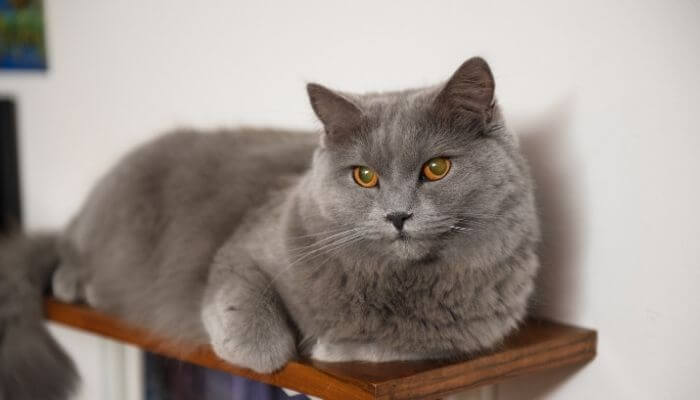
The typical head shape of a Chartreux is round, and the sides are so smooth that these pets can sometimes look as if they are smiling.
Their ears are erect and medium-sized, and their eyes can be any colour from gold to copper.
This cat breed’s body is muscular. Most pets have a deep chest, broad shoulders, and somewhat short legs.
Chartreux Cat Temperament
The personality of the Chartreux is one of the most important reasons so many pet lovers choose this breed.
It’s affectionate, easily adaptable, and it can even be considered a lap cat.
You’ll find that your Chartreux will love to spend time with you, whether playing or just lazing around next to you or on the couch, watching TV.
These cats’ nature is sweet and amenable, and they also tend to get well with anyone, including children, which makes them the perfect pets for families.
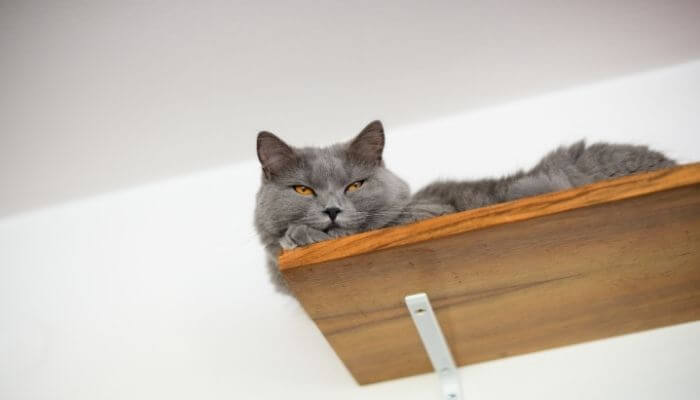
Even though they have , Chartreux cats love to share their living space with other companions, be they human or feline.
When they want your attention, they’re known to chirp. Otherwise, you aren’t going to complain about your Chartreux meowing all the time.
Despite , they can be inquisitive and develop destructive behaviours if they are left by themselves for many hours during the day.
Another aspect worth noting about the breed is that it loves climbing and on surfaces. For this reason, we recommend getting some good-quality cat perches and .
Chartreux Cat Health
Some of the most common illnesses that can affect this breed are the following:
- Ear infections
- Arthritis
- Hyperthyroidism
- Obesity
- Polycystic kidney disease
- Struvite stones
- Cancer (typically after the age of 7)
Chartreux cats can also develop patellar luxation, which can lead to lameness if it is not treated in due time.
Unfortunately, this is a genetically transmitted condition, so make sure to get your kitten from a reputable breeder, one that can show you proof that the pet’s parents didn’t suffer from this disease.
Two other typical health issues that affect most cats and the Chartreux makes no exception, are periodontal disease and gingivitis.

Most cats can put up a fight if you try to clean their teeth regularly, but your veterinarian can instruct you on the correct procedure and the products you should use for the purpose.
Although most cats tend to put on weight as they age, the Chartreux is prone to obesity after the age of 4 to 5.
This is even more common in cats that were neutered or spayed early.
Caring for a Chartreux Cat
The best thing about this breed is that it is pretty self-sufficient.
Unlike other cats, Chartreux ones don’t require a lot of attention, but you should make a goal out of taking your pet to regular vet check-ups once or twice a year.
The frequency of yearly vet visits needs to be increased to 3 if you have a senior Chartreux.
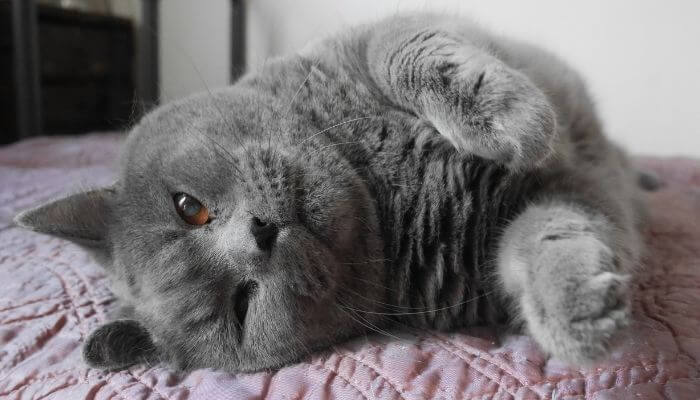
Since they are very curious, these cats will try to get into your cupboards or closets. Installing several toddler locks can swiftly solve this issue.
Boredom can be a problem for all pets, including Chartreux cats, which is why we recommend spending some quality time with your feline friend every day. This means that you should do your best at playing with them for at least 10 to 15 minutes per day.
If you tend to be away from home for a long time on a daily basis, it would be helpful for you to invest in some quality interactive toys so that your Chartreux doesn’t have to look for entertainment opportunities elsewhere.
Although most cats are sensitive animals, and they can easily develop anxiety if you move home or travel, this breed is known for being extremely adaptable.
Some of them even enjoy .
Feeding a Chartreux Cat
When it comes to your Chartreux’s diet, you don’t have to worry about too much other than finding the right .
Kittens do well with a standard diet specifically designed for them so long as it’s free of artificial colours and additives.
However, since this cat breed is prone to developing urinary tract health problems, you should aim at finding .

Urinary health issues can also be caused by a lack of appetite for water, and cats, in general, aren’t known for drinking a lot of it.
For this reason, it might be a better idea for you to exclusively feed your Chartreux canned food.
If your Chartreux is overweight or obese, you can partially solve the problem by investing in an interactive feeder, where the cat would have to ‘hunt’ for the kibble or treats.
Busy pet parents can also get an automatic pet feeder if they would also want to feed their cats a dry diet (at least for the duration of their absence or at night).
Needless to say, Chartreux cats shouldn’t be fed human food, especially those that contain spices, condiments, or seasonings like salt and pepper (though some spices such as can have health benefits in small doses if your cat will tolerate it). If you’re interested in a raw alternative, you can make your own cat food at home — just ask your vet about this beforehand.
Also, if you intend to change your cat’s diet, you should do so gradually. Adjusting cats to new foods can take some time, and it’s a good idea to mix some of the new food with the old one gradually.
Bathing
Should you bathe your Chartreux? The typical answer to this question is no. Most cats, and this breed, too, do a good job of cleaning their own bodies.
Even so, if your Chartreux got out of the house and managed to get really dirty, you might have to give him or her a bath. .
Giving your feline companion baths more often than that can not only be stressful, as most cats hate water, but it can also lead to your pet developing a number of skin issues (such as dermatitis).
Bathing your cat is also a rather complicated process since your Chartreux has a double coat, so saturating it can take some time and effort. If you do have to bathe your cat, always use a pet shampoo.
There’s also the option of you using a waterless , which usually comes in the form of a powder or foam.
Grooming
A Chartreux’s coat is soft and woolly and it doesn’t call for a lot of care. Even so, it’s highly recommended that you take some time to brush your feline friend’s coat every week.
This breed tends to shed several times a year, which means that it is not hypoallergenic.
Given the flying fur and the that a Chartreux can produce, this breed does not make the best one for people with asthma and other respiratory issues.
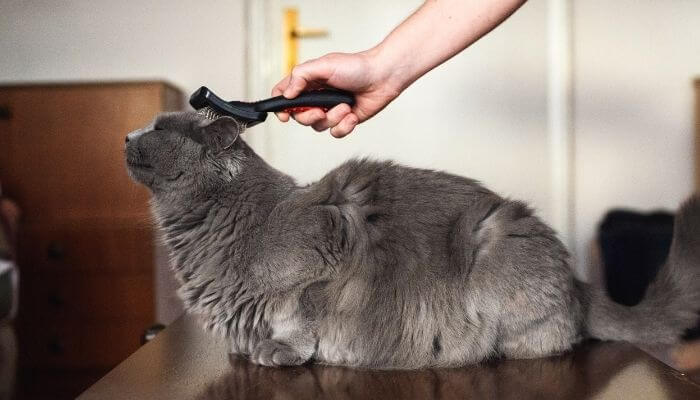
In the warm season, when cats tend to shed more than in the winter, you can even take your Chartreux to a specialised groomer and give them a haircut.
The rest of the grooming that your cat needs is standard. You should trim their nails every two weeks and brush their teeth with a toothpaste that your veterinarian has recommended or approved of.
Regular dental cleanings at the vet clinic should be done at least once or twice a year.
Finding a Chartreux Kitten
While this breed is fairly common, especially compared to the Ukrainian Levkoy or the Toyger, you want to get your kitten from the best breeder in your area or country.
Try to look for some information online and make sure to consult some of the best Chartreux websites, such as the or the .
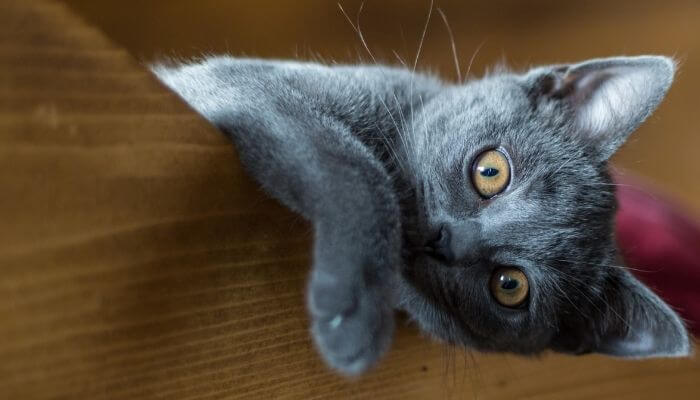
There are many Chartreux groups on social media, too, that you can use to get in touch with other Chartreux owners. You can ask them where they got their kittens and what breeders they recommend.
Once you have found the right breeder, you should still take everything they tell you with a grain of salt. A warning sign would be a breeder that tells you that their cats are completely healthy in every way.
A responsible breeder, on the other hand, will inform you about the health challenges they have had to manage in the past. They will also tell you what certifications they have, what vets they use, and if they have any health certificates for the kitten’s parents.

You need to have some amount of patience as most breeders are reluctant when it comes to letting go of their kittens before they get to 10 to 12 weeks of age. In fact, this is the best solution for everyone as it can prevent health problems in kittens.
Some breeders deworm and vaccinate the kittens and instruct you on how you should continue the vaccination plan.
Adopting a Chartreux can be another option, depending on the country you are located in.
In the United States, the United Kingdom, and France, where this breed is a bit more common, you can look for adoption groups and shelters and see whether they don’t have a Chartreux whose pet parent you could become.
Also Read:
How much does a Chartreux cost?
It depends on where you get your cat from.
Well-bred and healthy kittens can be as expensive as £850/$1,200 to £1000/$1,500, but the sky’s the limit when it comes to how much you can pay for a Chartreux.
An excellent pedigree kitten is known to cost anything between £1500/$2,000 and £1800/$2,500. Prices like £200/$300 are uncommon for a perfectly healthy kitten, one that you get from a reputable breeder.
Chartreux Cat Names
Popular male Chartreux names:
- Anton
- Champagne
- Francois (or Frank)
- Jacques
- Jules
- Leon
- Luc
Popular female Chartreux names:
- Aimee (or Amy)
- Amelie
- Celine
- Claire
- Gigi
- Honey
- Michelle
Summary
The Chartreux is one of the oldest cat breeds out there. These cats are calm, friendly, and easily adaptable, and they get along with other pets and children.
They’re affectionate and perfectly happy to spend a lot of time in your lap. They also don’t meow a lot, especially at night.
Since kidney and bladder problems are fairly common in this breed, you should feed your feline friend a low-alkaline diet.
When you adopt or purchase a Chartreux kitten, you’re making a long-term commitment, as it’s not uncommon for these cats to live for 15 to 20 years.
They , where they have a lower chance of catching diseases from other animals.
Sources:

